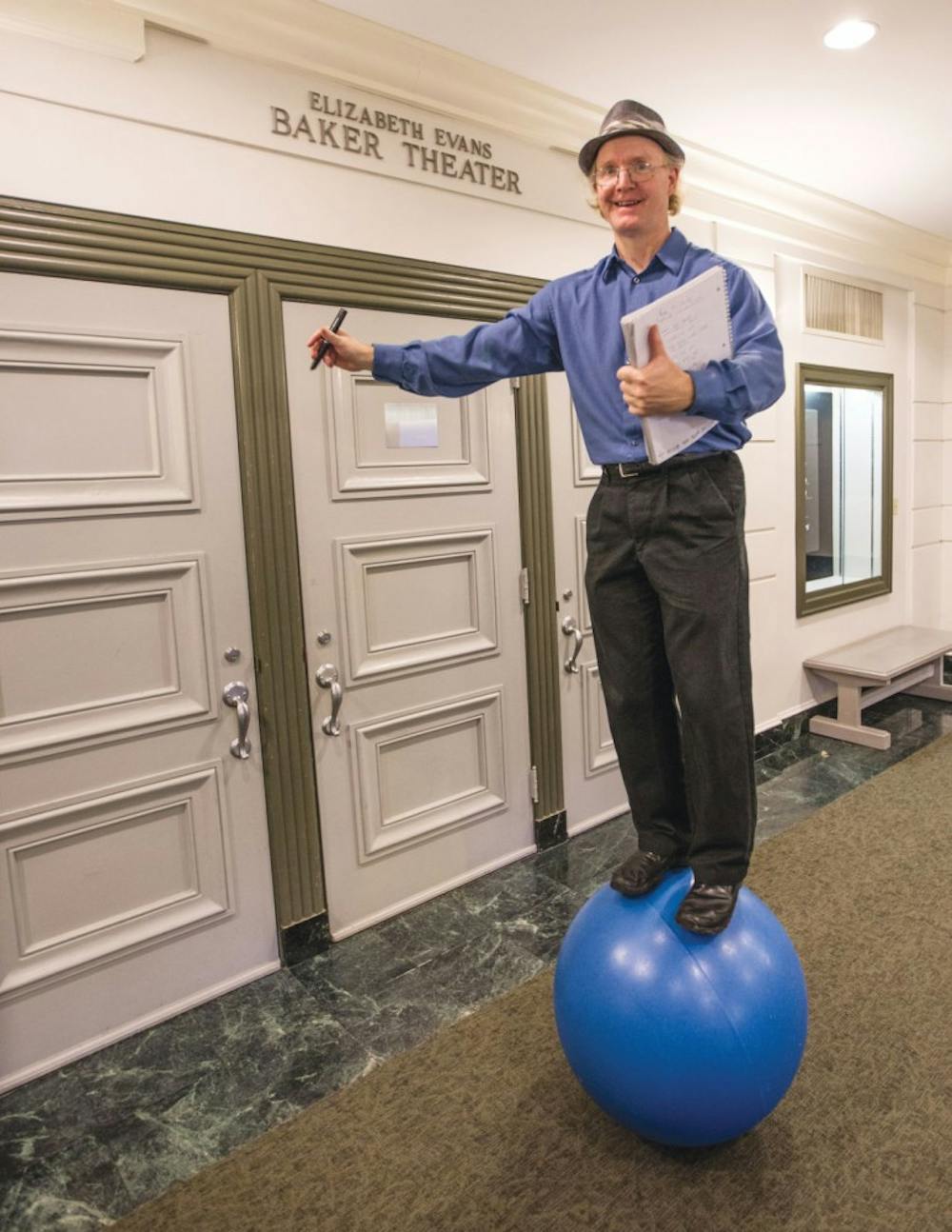Richardson visited Athens during the week of March 7 to teach undergraduate actors how to have fun with their craft.
Drew the Dramatic Fool’s business card claims that he is “79 percent better than TV.”
Visiting Athens as a guest artist in the Division of Theater, Drew Richardson, a 1986 alumnus from Ohio University, taught three undergraduate classes during the week of March 7.
He said he wanted to teach students “how to play.”
“There is a reason the scripts are called plays,” he said. "They’re not called ‘seriouses.’ ”
Focusing on instilling a sense of creativity and spontaneity, he said he wanted students to open up through clowning.
“In some ways, to fail is to succeed,” he said. “It makes the character more human. I think we all want to present this ideal version of ourselves and something happens — we knock something over, we forget our car keys, we bump into something — and we are reminded that we are human.”
After graduating from OU, Richardson traveled to Paris for a year to study at the internationally renowned École Internationale de Théâtre Jacques Lecoq. David Haugen, an OU associate professor of performance, said Richardson’s study at the school was one of the reasons he brought Richardson back.
Haugen said he wanted Richardson to teach his students how to use clowning as a way to learn universal acting elements.
“There are so many different elements in clowning that help the actor: timing, working with precision,” Haugen said. "If you are working with no words, you have to work with such precision."
Perri Olson, a freshman studying theater, said the class opened up a whole new world to her.
With an extensive acting background, Olson has previous experience in clowning — but of a different sort. Her training focused on physical comedy.
“What most people think of is birthday parties (and) serial killer clowns,” Olson said. “(But) you can be a clown without costumes or stereotypes.”
{{tncms-asset app="editorial" id="f410dfd8-eba6-11e5-abad-43d0014f5e44"}}
Olson cited Lucille Ball of the classic I Love Lucy as an example of a clown played without the stereotypes — she was just a normal character.
Before Richardson’s visit, Olson had never worn a red clown nose. She said an important lesson she learned through his exercises was to be a “beautiful idiot” on stage.
The classes allowed her to find an awareness of herself and an awareness of the energy in the room, which she said are important parts of acting.
“Part of clowning is identifying your insecurities,” she said.
In fact, Richardson said his interest in magic, in addition to juggling and entertaining friends at school, helped him break out of his shell.
Haugen said clowning also teaches performers how to create a relationship with an audience. One rule dictates that the performer cannot break contact with the audience for more than three seconds.
“There’s this whole interaction,” Haugen said. “It makes you just take this ride with them.”
Richardson has taught at Point Park Conservatory of Performing Arts and Virginia Commonwealth University. He recently went back to school as a student at Virginia Commonwealth University for those “magic MFA letters.” Richardson teaches physical training for the actor.
“(Physical training) makes (actors) more present, more alive on stage,” Richardson said. “They learn who they are and all their imperfections and habits, and they can then choose how to use that, whether for comedic effect or to hide it in another character.”
Clowning is where comedy is found in physical theater, but Haugen said the comedy is not just about blowing up balloons and making funny noises.
“I think even in really funny clowning, there is a huge amount of heart to it,” he said.
The multi-award winning Slava’s SnowShow is an example Haugen gave of that heart. In one act, the clown creates an emotional connection with a coat he has brought to life.
“There’s a storyline there, there’s absolutely a narrative,” Haugen said. “He’s got the red nose in that, but it’s incredibly moving.”
{{tncms-asset app="editorial" id="3c719d00-d93a-11e5-b1b7-df77f53afba0"}}
Haugen said heart is present in Richardson’s work, as well.
“There’s something about the fool, Drew’s characters, that just brings an incredible amount of humanity,” Haugen said.
Richardson’s own performances tend to highlight the absurd and the impossible, such as when he attempts to juggle 36 balls, saw himself in half, walk on a ball with his foot stuck in a bucket and jump rope.
“I don’t succeed, but I do in my own way,” Richardson said.
@graceoliviahill
gh663014@ohio.edu






